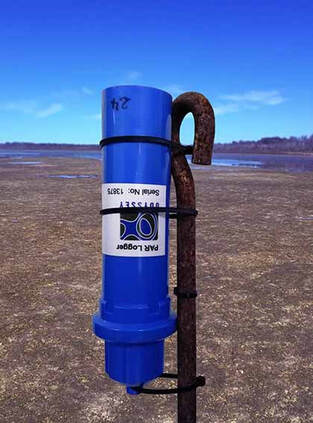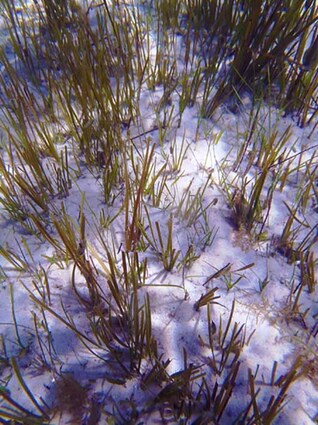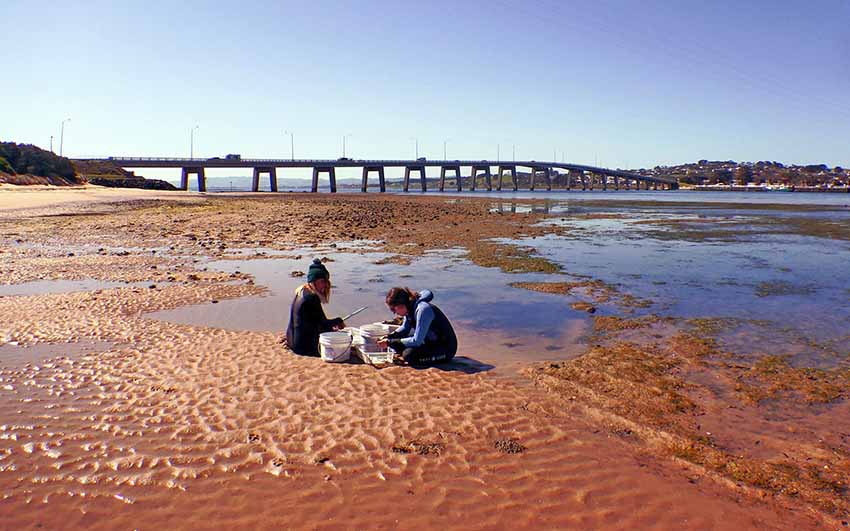FIFTEEN months on from my first meeting with the young scientists as described in my article A watery makeover, I found them again at Queensferry, early one Sunday morning.
Yi Mei and Oli were trudging through the intertidal zone some 80 metres or so offshore. They were ‘examining things’ in the mud. This time I had to find out exactly what they were doing for it looked amusing but, at the same time, very serious.
Yi Mei (Yi Mei Tan – PhD candidate, Deakin University) is researching the methods of how the team can restore seagrasses within Western Port and answer questions like:
- should individual plants or seeds be planted;
- how should the plants be stored and looked after before they are introduced to the restoration site?
Oli (Oliver Dalby – PhD candidate, Deakin University) is researching where the team should be focussing their restoration efforts. This includes pinpointing the current distribution of seagrasses within Western Port and identifying suitable areas for restoration using computer models, satellite images, and fieldwork.
When they eventually reached dry land and started back along the beach, they recognised me and knew what I was up to!
With a cheeky grin, I said hello and asked, “What are you doing now?”
They both smiled and then very seriously Oli replied, “We are burying Photosynthetic Active Radiation devices.”
“Ah, Mm”, I muttered.
 Photosynthetic Active Radiation Logger
Photosynthetic Active Radiation Logger He added, “We collect the readings every two to three weeks. It enables us to compare data from the other sites where we have deployed the PAR loggers to see whether the amount of light present varies between the mudflats from Corinella to Grantville. The measurements obtained will help us determine the optimum seagrass planting sites.”
As we walked along the beach back to their ‘food and communication’s vehicle’ (a small SUV), Yi Mei explained that to help with this task, they were also collecting data on the water quality at regular intervals using a Multi-parameter Sonde Meter. This device measures turbidity, salinity, temperature and pH levels.
This point interested me, for I was aware that seagrass had to contend with water turbidity caused by foreshore erosion and nutrients flowing into Western Port from the catchment areas.
I asked Yi Mei if these ‘pollutants’ were continuing to affect seagrass growth and their efforts to eventually plant more.
Yi Mei paused momentarily and, looking out towards a misty French Island, went on to say, “Yes, these factors are still affecting seagrass propagation, but as part of our restoration research we are working out what conditions seagrasses need to grow. Like terrestrial plants, seagrasses need a certain set of environmental conditions to flourish: enough light, stable sediment, and enough nutrients, etcetera. At this stage, we are now seeing some recovery in different parts of Western Port and this will help us understand which sites may be suitable for restoration.”
Yi Mei concluded, “Our research on the mudflats looks into how these environmental variables between the sites with high, medium and low amounts of seagrass will influence where we focus our restoration efforts in the future.”
Earlier, while I’d been waiting for the team to come out of the mud, I’d been checking some recently planted mangrove seedlings and the seagrass accumulating around them. I knew of two types of seagrasses growing in Western Port: Zostera muelleri and Heterozostera nigricaulis and now was the time to try out my Latin pronunciation. However, it wasn’t necessary, for Oli saved the day!
 Zostera muelleri, Photo:Jacqui Pocklington
Zostera muelleri, Photo:Jacqui Pocklington “We are concentrating on Zostera muelleri for we believe we will be able to sow these seeds and seedlings in the areas we will later nominate as sites likely to help them germinate and grow.”
I thought I’d leave the question of how they were going to grow the Zostera muelleri for another time, for I too had to rehydrate!
As I was saying goodbye, Oli’s mobile rang. It was Craig (Dr Craig Sherman, their PhD supervisor, Deakin University) calling to talk about their progress. When finished, Oli handed the phone to me for he guessed I had a question or two.
Craig indicated that Yi Mei and Oli’s projects have significantly advanced our knowledge of the current status of seagrass in Western Port. They are helping us understand the historical changes that have taken place, and, most importantly, are meticulously investigating the methods and approaches we can use to restore and rehabilitate suitable sites in Western Port.
He went on to say, “There is still much to learn for we are currently in the early stages of a long-term program. Sure there will be set backs and failures along the way, but we will learn from those and work out the most appropriate approaches that enable us to restore and rehabilitate these key ecosystems in Western Port.”
From my earlier meeting with the team, I was aware that Melbourne Water was playing a major role in this research. Craig said, “This seagrass project is part of a broader Melbourne Water research program that has been underway over the past decade. It is being conducted in partnership with a range of government agencies and leading environmental scientists to improve our knowledge of Western Port’s marine and coastal environment.”
“Morning,” called the walking group as they went by once more. We waved back as Yi Mei and Oli set off to take on the mud and their scientia experimenta.
Yi Mei and Oli hope to finish their PhDs in the coming twelve months but in the meantime they’ll be back, so I guess I’ll have to keep working on my Latin, just in case I need it.
